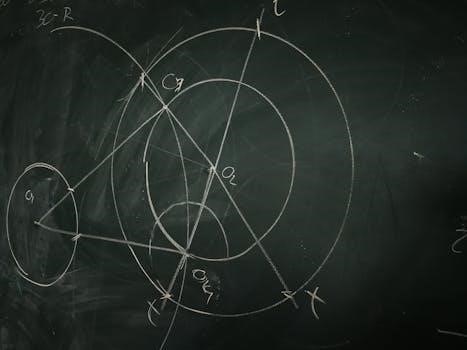
Understanding area and perimeter is fundamental in geometry, dealing with the measurement of two-dimensional shapes. Area calculates the space inside a shape, while perimeter measures the distance around its boundary. These concepts are crucial for various real-world applications.
Understanding 2D Shapes and Their Measurements
Two-dimensional shapes, or 2D shapes, are flat figures that exist in a plane and have only two dimensions⁚ length and width. These shapes include familiar figures like squares, rectangles, triangles, and circles. Measuring these shapes involves two primary concepts⁚ area and perimeter. Area refers to the amount of surface a 2D shape covers and is typically measured in square units, such as square centimeters (cm²) or square meters (m²). Understanding area is essential for tasks like calculating the space a room occupies. Perimeter, on the other hand, is the total distance around the outside edge of a 2D shape. It’s measured in linear units like centimeters (cm) or meters (m). Knowing the perimeter is useful for determining the amount of fencing needed for a garden or the length of trim needed for a room. Mastering the formulas for area and perimeter of different 2D shapes is important for both academic and practical applications, and provides a foundation for understanding more complex geometric concepts. These measurements are fundamental in various fields including construction, engineering, and design.

Basic 2D Shapes⁚ Formulas for Area and Perimeter
This section explores fundamental 2D shapes such as squares, rectangles, triangles, and circles. We’ll detail the specific formulas required to calculate their area and perimeter, essential for practical applications.
Formulas for Squares and Rectangles
Let’s begin with two of the most basic shapes⁚ squares and rectangles. For a square, where all four sides are of equal length (denoted as ‘s’), the perimeter is calculated by adding up all sides, or simply 4 * s. The area, representing the space enclosed within the square, is given by s * s or s². Moving to rectangles, they have two pairs of equal sides⁚ length (l) and width (w). The perimeter of a rectangle is found by adding all sides, which can be expressed as 2 * l + 2 * w. The area of a rectangle is calculated by multiplying its length and width, resulting in l * w. Understanding these basic formulas is essential for more complex geometric calculations. These shapes form the building blocks for understanding other shapes.
Formulas for Triangles (Right, Isosceles, Equilateral)
Triangles, a fundamental shape in geometry, come in various forms, each with its own set of formulas. For any triangle, the perimeter is simply the sum of all its sides (a + b + c). However, calculating the area differs. For a right triangle, where one angle is 90 degrees, the area is half the product of its base (b) and height (h), i.e., (1/2) * b * h. An isosceles triangle has two sides of equal length (a), and its perimeter is 2a + b. The area of an isosceles triangle is found using (b/4) * √(4a² ⎼ b²), where b is the unequal side. An equilateral triangle, where all three sides are equal (a), has a perimeter of 3a and an area of (√3/4) * a². Each type presents a unique calculation method.
Formulas for Parallelograms and Rhombuses
Parallelograms and rhombuses, both quadrilaterals, possess unique properties that influence their area and perimeter calculations. A parallelogram, with opposite sides parallel and equal, has a perimeter of 2 * (length + width). Its area is found by multiplying the base (b) by the height (h), where the height is the perpendicular distance between the base and its opposite side. For a rhombus, which is a special type of parallelogram with all sides equal, the perimeter is calculated as 4 * side (a). The area of a rhombus can be calculated in two ways⁚ either by multiplying base (b) and height (h) or by using its diagonals (d1 and d2), where the area is (1/2) * d1 * d2. These differences are important for various geometric problems. Understanding these distinctions is crucial.
Formulas for Trapezoids and Kites
Trapezoids and kites are distinct quadrilaterals, each with specific formulas for area and perimeter. A trapezoid, characterized by having at least one pair of parallel sides, has a perimeter calculated by summing all its sides. The area of a trapezoid is found by multiplying half of the sum of its parallel sides (b1 and b2) by its height (h), represented as (1/2) * (b1 + b2) * h. A kite, with two pairs of adjacent equal sides, has a perimeter equal to the sum of all its sides. The area of a kite is determined by half the product of its diagonals (d1 and d2), expressed as (1/2) * d1 * d2. These formulas are essential for accurately determining the space enclosed and the total length around these unique shapes. Understanding these distinctions is essential.
Formulas for Circles (Area and Circumference)
Circles, defined by their constant radius from a central point, possess unique formulas for area and circumference. The area of a circle is calculated using the formula A = πr², where ‘π’ (pi) is a mathematical constant approximately equal to 3.14159, and ‘r’ represents the circle’s radius. The circumference, which is the perimeter of the circle, is determined using the formula C = 2πr, or alternatively, C = πd, where ‘d’ is the diameter of the circle (twice the radius). These formulas are fundamental in various mathematical and scientific applications. Understanding the relationship between a circle’s radius, diameter, area, and circumference is crucial for solving problems involving circular shapes. The use of pi makes calculations precise. These equations are used in many fields.

Advanced 2D Shapes⁚ Formulas and Concepts
Beyond basic shapes, we explore more complex 2D figures. This section delves into the formulas and concepts necessary for understanding and calculating the area and perimeter of regular polygons and other advanced shapes.
Regular Polygons⁚ Area and Perimeter Calculation
Regular polygons, characterized by equal side lengths and equal interior angles, require specific formulas for calculating their area and perimeter. The perimeter of a regular polygon is found by simply multiplying the length of one side by the number of sides. Calculating the area is a bit more involved and often requires using the apothem, which is the line segment from the center of the polygon to the midpoint of a side. For an n-sided regular polygon with side length ‘s’ and apothem ‘a’, the area can be calculated using the formula⁚ Area = (1/2) * perimeter * apothem, or Area = (1/2) * n * s * a. This method applies to any regular polygon, such as pentagons, hexagons, octagons, and beyond. The apothem can be determined by using trigonometry, depending on the polygon’s side length. Understanding these calculations is essential for various applications in geometry and design.

Practical Applications of Area and Perimeter
Area and perimeter calculations are essential in real-world scenarios, from construction and landscaping to interior design and agriculture. Understanding these formulas helps solve practical problems and make informed decisions.
Real-World Examples and Problem Solving
The application of area and perimeter extends to numerous real-world situations, demonstrating their practical importance. Consider, for example, laying carpet in a room; calculating the area of the floor is crucial to determine how much carpeting is needed. Similarly, when building a fence around a garden, knowing the perimeter helps determine the amount of fencing material required. In agriculture, farmers use area calculations to determine the quantity of seeds or fertilizers needed for a field. Interior designers rely on both area and perimeter to arrange furniture and calculate the amount of wallpaper or paint needed. These concepts are also essential in architecture and construction, ensuring that buildings are constructed correctly and efficiently. Even simple tasks like wrapping a gift or making a frame require a basic understanding of perimeter and area. By mastering these formulas, we can solve everyday problems with ease and efficiency, making informed decisions in various aspects of our lives. Understanding these concepts allows us to tackle practical challenges, from home improvements to professional projects.

PDF Resources for Area and Perimeter Formulas
For convenient access, downloadable PDF resources are available. These sheets provide a compilation of area and perimeter formulas for various 2D shapes, ideal for quick reference and study purposes.
Availability of Downloadable Formula Sheets
Numerous online platforms offer downloadable PDF formula sheets that compile area and perimeter formulas for a wide range of two-dimensional shapes. These resources are invaluable for students, educators, and anyone needing a quick reference guide. These sheets typically include formulas for basic shapes such as squares, rectangles, triangles, and circles, as well as more complex shapes like parallelograms, rhombuses, trapezoids, and kites. Additionally, some comprehensive sheets may also include formulas for regular polygons and even sectors or ellipses. The PDF format ensures easy accessibility across various devices, allowing users to print them out or view them digitally. These formula sheets often present the information in a clear and organized manner, making it simple to locate the specific formula required. They can be a great aid for studying, completing assignments, or problem-solving in real-world applications. The availability of these free resources online makes mastering area and perimeter calculations significantly more convenient and efficient.